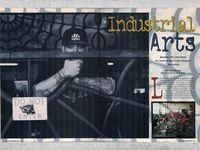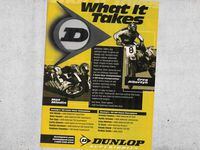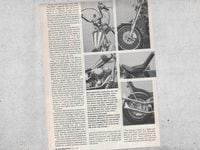Industrial Art: Beauties with some beast: the works of West Coast Choppers' Jesse James
John Burns penned this January 2000 article, painting a mysteriously beautiful picture of an industrial town in decay. The mighty port of Los Angeles which is situated at the end of the 710 Freeway in Long Beach, California, is the location of this story. A town that used to build things and was once home to Los Angeles native Jesse James and his West Coast Choppers shop.
Situated in an old paint factory in a town that used to make things was a crew of 31 craftsman turning out a range of custom gear and machines. These things ranged from one-of-a-kind motorcycles to short-run semi-custom choppers, and other unique parts for the individualist building in their garages across the nation and the world. All of this lead by a rugged individualist and artist with a vision and respect for traditional building methods.
James’ history includes a wide range of careers including that as a nose guard at UC Riverside, going to an anti-terrorism school, being a bodyguard in Europe for bands, and as a hot rod builder for Boyd Coddington. Working for Boyd gave Jesse access to a lot of the old school builders that were masters of hand building techniques where he learned as many tricks and skills from as he could. Jesse also absorbed every book on metallurgy he could get his hands on and walked away from Coddington Customs with a respect for the clean aesthetic of his builds and a better knowledge on running a business.
Most of James’ business was made selling fenders, rigid kits, and merchandise. He also spent a fair amount of time in Europe building his brand.
Regardless of what you think of the man, his WCC creations were sculptures in metal and are still highly sought after. He's currently building custom bikes and firearms in Texas.
Captain America Replica: Wanna play Peter Fonda?
This feature from the January 2000 issue of Motorcyclist opened at a traffic light with something that could be the final scene to the iconic Easy Rider movie. Unlike the movie, Roland Brown (the author) was not blasted out of the saddle from a pickup but met with a beaming smile. As Brown motored away from the light he described his current tester as what must be the most evocative, and least practical of motorcycles to be put into series production.
What happened to the original Captain America bike is unknown. Two were built for the low-budget 1969 film Easy Rider. One was burned up while filming the closing scene and shortly after the film was completed, the second was stolen along with the other two bikes built for Peter Fonda's costar Dennis Hopper. Several people have built replicas over the years and occasionally tried to pass them off as the original, but the fate of the last Captain America bike is unknown.
It wasn’t until later that Peter Fonda and his business compatriot Randy White partnered with California Motorcycle Company (CMC) to bring the movie back to life through replicas of the two famous choppers. In addition to the 750 Captain America bikes they planned to build, there was also a Billy (Dennis Hopper) bike planned to compliment it.
Making this a contemporary roadworthy machine required a few updates. The radical forks which were 254mm longer than standard were raked out to 36 degrees compared to the 30-year-old original which had a 42-degree rake. The modern S&S motor is an 88 incher with period correct Panhead valve covers. Like the original, the Captain America reproduction had a 21-inch front wheel but this remake included a mudguard and a front brake.
Another feature that Fonda may have appreciated during production of Easy Rider might have been the inclusion of an electric starter, which the CMC machine got. During filming, Fonda managed to hurt his foot while kick-starting the machine.
One of the first impressions the author felt was that the exhaust note from the fishtail pipes was more subtle than expected. The bike tracked straight and true. That said, in the corners the long forks and theincreased rake made the machine feel like it was getting tangled up. Although Brown did not ride this bike any real distance, he had the impression that it was not built to do so. He did find it to be fun to ride and as cool as the original.










/cloudfront-us-east-1.images.arcpublishing.com/octane/2KONJUQOD6HGH3NQJPTBYJNONM.jpg)







/cloudfront-us-east-1.images.arcpublishing.com/octane/MUQLOVLL2ZDGFH25ILABNBXKTI.jpg)
/cloudfront-us-east-1.images.arcpublishing.com/octane/TNOU5DNE2BC57MFPMGN2EIDXAM.jpg)
/cloudfront-us-east-1.images.arcpublishing.com/octane/GTCXACQGJ5HAPDTGWUQKDEH44E.jpg)
/cloudfront-us-east-1.images.arcpublishing.com/octane/S35YGSEMEZB4BLTDJTSZPF4GLA.jpg)
/cloudfront-us-east-1.images.arcpublishing.com/octane/5UOT6HPX2JFMRJAX6EH45AR4MQ.jpg)
/cloudfront-us-east-1.images.arcpublishing.com/octane/OKWOJWAKP5EP3OACCRRWPCIX2Q.jpg)
/cloudfront-us-east-1.images.arcpublishing.com/octane/2WF3SCE3NFBQXLDNJM7KMXA45E.jpg)
/cloudfront-us-east-1.images.arcpublishing.com/octane/G4MG6OUCJNBSHIS2MVVOTPX65E.jpg)
/cloudfront-us-east-1.images.arcpublishing.com/octane/IIGGWFOTOJGB7DB6DGBXCCMTDY.jpg)
/cloudfront-us-east-1.images.arcpublishing.com/octane/QSTCM6AVEZA5JJBUXNIQ3DSOF4.jpg)
/cloudfront-us-east-1.images.arcpublishing.com/octane/U4I7G625B5DMLF2DVIJDFZVV6M.jpg)
/cloudfront-us-east-1.images.arcpublishing.com/octane/B6XD6LS6IVCQPIU6HXDJSM3FHY.jpg)
/cloudfront-us-east-1.images.arcpublishing.com/octane/ICL63FEDDRDTTMINYICCEYGMDA.jpg)
/cloudfront-us-east-1.images.arcpublishing.com/octane/FCGZHQXRBZFLBAPC5SDIQLVF4I.jpg)
/cloudfront-us-east-1.images.arcpublishing.com/octane/WNOB6LDOIFFHJKPSVIWDYUGOPM.jpg)

/cloudfront-us-east-1.images.arcpublishing.com/octane/X33NU3E525ECRHXLNUJN2FTRKI.jpg)
/cloudfront-us-east-1.images.arcpublishing.com/octane/6KKT5NNL2JAVBOXMZYS5ZO76YA.jpg)
/cloudfront-us-east-1.images.arcpublishing.com/octane/J5RKG5O455GMPGQRF2OG6LRT7A.jpg)
/cloudfront-us-east-1.images.arcpublishing.com/octane/GX2CIZKQVRH2TATDM26KFG2DAE.jpg)
/cloudfront-us-east-1.images.arcpublishing.com/octane/ZWIDYSAKQZHD5BHREMQILXJCGM.jpg)
/cloudfront-us-east-1.images.arcpublishing.com/octane/CYUHJZCTSJCH3MRAQEIKXK7SCQ.jpg)
/cloudfront-us-east-1.images.arcpublishing.com/octane/LKOFINY56FCXJCANJ5M7ZDQUBY.jpg)
/cloudfront-us-east-1.images.arcpublishing.com/octane/4NBPDACMWJH63JQYJVK3QRBDZI.jpg)